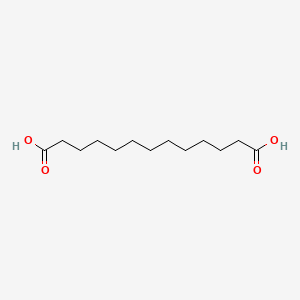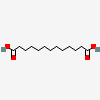Tridecanedioic acid
- TRIDECANEDIOIC ACID
- 505-52-2
- 1,11-Undecanedicarboxylic acid
- Brassylic acid
- Brassilic acid
- Create:2005-03-26
- Modify:2025-01-04

- 1,11-undecanedicarboxylic acid
- brassylic acid
- tridecanedioic acid
- tridecanedioic acid, disodium salt
- tridecanedioic acid, monosodium salt
- TRIDECANEDIOIC ACID
- 505-52-2
- 1,11-Undecanedicarboxylic acid
- Brassylic acid
- Brassilic acid
- 1,13-Tridecanedioic acid
- Brassylate
- tridecanedioate
- Brassilate
- UNII-PL3IQ40C34
- PL3IQ40C34
- DTXSID9021683
- CHEBI:73718
- 1,13-Tridecanedioate
- Undecane-1,11-dicarboxylic acid
- NSC 9498
- NSC-9498
- EINECS 208-011-4
- 1,11-Undecanedicarboxylate
- Undecane-1,11-dicarboxylate
- AI3-18168
- DTXCID901683
- NSC9498
- EC 208-011-4
- .ALPHA.,.OMEGA.-TRIDECANEDIOIC ACID
- CAS-505-52-2
- 1,13-Tridecanedioic Acid; Brassylic Acid; NSC 9498; a,?-Tridecanedioic Acid; ?-Carboxylauric Acid;
- MFCD00002740
- TRIDECANEDIOICACID
- SCHEMBL20802
- alpha,omega-tridecanedioic acid
- CHEMBL3187746
- 1, 11-Undecanedicarboxylic acid
- Tox21_201301
- Tox21_302982
- LMFA01170014
- s6063
- STK033041
- AKOS005381208
- 1,11-Undecanedicarboxylic acid, 94%
- NCGC00249020-01
- NCGC00249020-02
- NCGC00256463-01
- NCGC00258853-01
- AS-14882
- DB-121159
- HY-128421
- CS-0099256
- NS00010118
- T0021
- AB01332661-02
- EN300-6476962
- Q2099072
- Z87002486
181.1599 100
225.1497 58.04
243.1601 10.97
179.1443 6.94
57.0346 5.27
181.1598 100
225.1496 85.85
243.1601 21.32
199.1704 1.91
179.1443 1.90
243.1601 999
225.1497 390
181.1599 89
199.1706 4
225.1496 999
243.16 692
181.1598 461
199.1704 19
179.1443 1
225.149618 999
181.159789 533
243.160183 102
199.170354 21
243.160183 999
225.149618 396
181.159789 87
- Adhesives and sealant chemicals
- Plasticizers
- Lubricants and lubricant additives
- Paint additives and coating additives not described by other categories
2019: <1,000,000 lb
2018: <1,000,000 lb
2017: <1,000,000 lb
2016: <1,000,000 lb
- Petroleum Lubricating Oil and Grease Manufacturing
- Adhesive Manufacturing
- Paint and Coating Manufacturing
- Plastics Material and Resin Manufacturing

H315 (28.7%): Causes skin irritation [Warning Skin corrosion/irritation]
H319 (100%): Causes serious eye irritation [Warning Serious eye damage/eye irritation]
H335 (28%): May cause respiratory irritation [Warning Specific target organ toxicity, single exposure; Respiratory tract irritation]
H412 (70%): Harmful to aquatic life with long lasting effects [Hazardous to the aquatic environment, long-term hazard]
P261, P264, P264+P265, P271, P273, P280, P302+P352, P304+P340, P305+P351+P338, P319, P321, P332+P317, P337+P317, P362+P364, P403+P233, P405, and P501
(The corresponding statement to each P-code can be found at the GHS Classification page.)
Aggregated GHS information provided per 150 reports by companies from 6 notifications to the ECHA C&L Inventory. Each notification may be associated with multiple companies.
Information may vary between notifications depending on impurities, additives, and other factors. The percentage value in parenthesis indicates the notified classification ratio from companies that provide hazard codes. Only hazard codes with percentage values above 10% are shown.
Skin Irrit. 2 (28.7%)
Eye Irrit. 2A (100%)
STOT SE 3 (28%)
Aquatic Chronic 3 (70%)
Silke Matysik, Caroline Ivanne Le Roy, Gerhard Liebisch, Sandrine Paule Claus. Metabolomics of fecal samples: A practical consideration. Trends in Food Science & Technology. Vol. 57, Part B, Nov. 2016, p.244-255: http://www.sciencedirect.com/science/article/pii/S0924224416301984
Patents are available for this chemical structure:
https://patentscope.wipo.int/search/en/result.jsf?inchikey=DXNCZXXFRKPEPY-UHFFFAOYSA-N
- CAS Common ChemistryLICENSEThe data from CAS Common Chemistry is provided under a CC-BY-NC 4.0 license, unless otherwise stated.https://creativecommons.org/licenses/by-nc/4.0/Tridecanedioic acidhttps://commonchemistry.cas.org/detail?cas_rn=505-52-2
- ChemIDplusTridecanedioic acidhttps://pubchem.ncbi.nlm.nih.gov/substance/?source=chemidplus&sourceid=0000505522ChemIDplus Chemical Information Classificationhttps://pubchem.ncbi.nlm.nih.gov/source/ChemIDplus
- DTP/NCILICENSEUnless otherwise indicated, all text within NCI products is free of copyright and may be reused without our permission. Credit the National Cancer Institute as the source.https://www.cancer.gov/policies/copyright-reuse
- EPA Chemical Data Reporting (CDR)LICENSEThe U.S. Government retains a nonexclusive, royalty-free license to publish or reproduce these documents, or allow others to do so, for U.S. Government purposes. These documents may be freely distributed and used for non-commercial, scientific and educational purposes.https://www.epa.gov/web-policies-and-procedures/epa-disclaimers#copyrightTridecanedioic acidhttps://www.epa.gov/chemical-data-reporting
- EPA Chemicals under the TSCATridecanedioic acidhttps://www.epa.gov/chemicals-under-tscaEPA TSCA Classificationhttps://www.epa.gov/tsca-inventory
- EPA DSSToxTridecanedioic acidhttps://comptox.epa.gov/dashboard/DTXSID9021683CompTox Chemicals Dashboard Chemical Listshttps://comptox.epa.gov/dashboard/chemical-lists/
- European Chemicals Agency (ECHA)LICENSEUse of the information, documents and data from the ECHA website is subject to the terms and conditions of this Legal Notice, and subject to other binding limitations provided for under applicable law, the information, documents and data made available on the ECHA website may be reproduced, distributed and/or used, totally or in part, for non-commercial purposes provided that ECHA is acknowledged as the source: "Source: European Chemicals Agency, http://echa.europa.eu/". Such acknowledgement must be included in each copy of the material. ECHA permits and encourages organisations and individuals to create links to the ECHA website under the following cumulative conditions: Links can only be made to webpages that provide a link to the Legal Notice page.https://echa.europa.eu/web/guest/legal-noticeTridecanedioic acidhttps://chem.echa.europa.eu/100.007.284Tridecanedioic acid (EC: 208-011-4)https://echa.europa.eu/information-on-chemicals/cl-inventory-database/-/discli/details/127251
- FDA Global Substance Registration System (GSRS)LICENSEUnless otherwise noted, the contents of the FDA website (www.fda.gov), both text and graphics, are not copyrighted. They are in the public domain and may be republished, reprinted and otherwise used freely by anyone without the need to obtain permission from FDA. Credit to the U.S. Food and Drug Administration as the source is appreciated but not required.https://www.fda.gov/about-fda/about-website/website-policies#linkingTRIDECANEDIOIC ACIDhttps://gsrs.ncats.nih.gov/ginas/app/beta/substances/PL3IQ40C34
- Human Metabolome Database (HMDB)LICENSEHMDB is offered to the public as a freely available resource. Use and re-distribution of the data, in whole or in part, for commercial purposes requires explicit permission of the authors and explicit acknowledgment of the source material (HMDB) and the original publication (see the HMDB citing page). We ask that users who download significant portions of the database cite the HMDB paper in any resulting publications.http://www.hmdb.ca/citing1,11-Undecanedicarboxylic acidhttp://www.hmdb.ca/metabolites/HMDB0002327HMDB0002327_nmr_one_1874https://hmdb.ca/metabolites/HMDB0002327#spectra
- New Zealand Environmental Protection Authority (EPA)LICENSEThis work is licensed under the Creative Commons Attribution-ShareAlike 4.0 International licence.https://www.epa.govt.nz/about-this-site/general-copyright-statement/
- ChEBITridecanedioic acidhttps://www.ebi.ac.uk/chebi/searchId.do?chebiId=CHEBI:73718
- LOTUS - the natural products occurrence databaseLICENSEThe code for LOTUS is released under the GNU General Public License v3.0.https://lotus.nprod.net/Tridecanedioic acidhttps://www.wikidata.org/wiki/Q2099072LOTUS Treehttps://lotus.naturalproducts.net/
- ChEMBLLICENSEAccess to the web interface of ChEMBL is made under the EBI's Terms of Use (http://www.ebi.ac.uk/Information/termsofuse.html). The ChEMBL data is made available on a Creative Commons Attribution-Share Alike 3.0 Unported License (http://creativecommons.org/licenses/by-sa/3.0/).http://www.ebi.ac.uk/Information/termsofuse.html
- Crystallography Open Database (COD)LICENSEAll data in the COD and the database itself are dedicated to the public domain and licensed under the CC0 License. Users of the data should acknowledge the original authors of the structural data.https://creativecommons.org/publicdomain/zero/1.0/
- FooDBLICENSEFooDB is offered to the public as a freely available resource. Use and re-distribution of the data, in whole or in part, for commercial purposes requires explicit permission of the authors and explicit acknowledgment of the source material (FooDB) and the original publication.https://foodb.ca/about1,11-Undecanedicarboxylic acidhttps://foodb.ca/compounds/FDB022963
- SpectraBasetridecanedioic acidhttps://spectrabase.com/spectrum/F9XVDROcEmp1,11-Undecanedicarboxylic acidhttps://spectrabase.com/spectrum/5LsXMUH1P4qTridecanedioic acidhttps://spectrabase.com/spectrum/IvyNoa0gnLfTridecanedioic acidhttps://spectrabase.com/spectrum/4L8nyJMvvvFTRIDECANEDIOIC ACIDhttps://spectrabase.com/spectrum/7KATugMvg6q1,11-Undecanedicarboxylic acidhttps://spectrabase.com/spectrum/IVN1Uwgi5MNTRIDECANEDIOIC ACIDhttps://spectrabase.com/spectrum/CmIOKif25KD1,11-Undecanedicarboxylic acidhttps://spectrabase.com/spectrum/3fuopSZgqvxTRIDECANEDIOIC ACIDhttps://spectrabase.com/spectrum/COj0NPBg8AHUndecane-1,11-dicarboxylic acidhttps://spectrabase.com/spectrum/K4qF05I3AMuUndecane-1,11-dicarboxylic acidhttps://spectrabase.com/spectrum/Lm3s343mth31,11-Undecanedicarboxylic acidhttps://spectrabase.com/spectrum/y5H4rXY4oQ
- NIST Mass Spectrometry Data CenterLICENSEData covered by the Standard Reference Data Act of 1968 as amended.https://www.nist.gov/srd/public-law1,11-Undecanedicarboxylic acidhttp://www.nist.gov/srd/nist1a.cfm
- Japan Chemical Substance Dictionary (Nikkaji)
- KNApSAcK Species-Metabolite Database
- West Coast Metabolomics Center-UC Davis1,11-Undecanedicarboxylic acid
- LIPID MAPSLipid Classificationhttps://www.lipidmaps.org/
- MassBank EuropeTridecanedioic acidhttps://massbank.eu/MassBank/Result.jsp?inchikey=DXNCZXXFRKPEPY-UHFFFAOYSA-N
- MassBank of North America (MoNA)LICENSEThe content of the MoNA database is licensed under CC BY 4.0.https://mona.fiehnlab.ucdavis.edu/documentation/license
- Metabolomics Workbench
- Springer Nature
- SpringerMaterialstridecanedioic acidhttps://materials.springer.com/substanceprofile/docs/smsid_thhcorpbeflalhrk
- Thieme ChemistryLICENSEThe Thieme Chemistry contribution within PubChem is provided under a CC-BY-NC-ND 4.0 license, unless otherwise stated.https://creativecommons.org/licenses/by-nc-nd/4.0/
- Wikidatatridecanedioic acidhttps://www.wikidata.org/wiki/Q2099072
- WikipediaBrassylic acidhttps://en.wikipedia.org/wiki/Brassylic_acid
- PubChem
- Medical Subject Headings (MeSH)LICENSEWorks produced by the U.S. government are not subject to copyright protection in the United States. Any such works found on National Library of Medicine (NLM) Web sites may be freely used or reproduced without permission in the U.S.https://www.nlm.nih.gov/copyright.htmltridecanedioic acidhttps://www.ncbi.nlm.nih.gov/mesh/67094073
- GHS Classification (UNECE)GHS Classification Treehttp://www.unece.org/trans/danger/publi/ghs/ghs_welcome_e.html
- NORMAN Suspect List ExchangeLICENSEData: CC-BY 4.0; Code (hosted by ECI, LCSB): Artistic-2.0https://creativecommons.org/licenses/by/4.0/NORMAN Suspect List Exchange Classificationhttps://www.norman-network.com/nds/SLE/
- EPA Substance Registry ServicesEPA SRS List Classificationhttps://sor.epa.gov/sor_internet/registry/substreg/LandingPage.do
- MolGenieMolGenie Organic Chemistry Ontologyhttps://github.com/MolGenie/ontology/
- PATENTSCOPE (WIPO)SID 403386340https://pubchem.ncbi.nlm.nih.gov/substance/403386340









